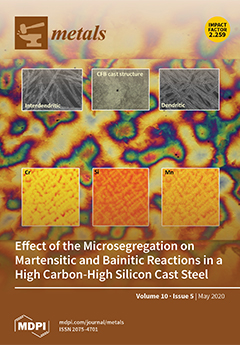Metals, Volume 10, Issue 5 (May 2020) – 147 articles
The central figure shows the dendritic solidification structure, revealed by color etching metallographic techniques and using light optical microscopy (LOM).
The figures labeled as Si, Mn, and Cr are the microsegregation maps of the chemical elements silicon, manganese, and chromium, respectively, as characterized by electron probe microanalysis (EPMA).
The figure labeled as CFB cast structure is a micrograph obtained by LOM, showing a carbide-free bainitic structure that was austempered at 230 °C for 360 min.
The figures labeled as Dendritic and Interdendritic are SEM micrographs that show detail of the carbide-free bainitic structure in these respective regions.
- Issues are regarded as officially published after their release is announced to the table of contents alert mailing list.
- You may sign up for e-mail alerts to receive table of contents of newly released issues.
- PDF is the official format for papers published in both, html and pdf forms. To view the papers in pdf format, click on the "PDF Full-text" link, and use the free Adobe Reader to open them.





